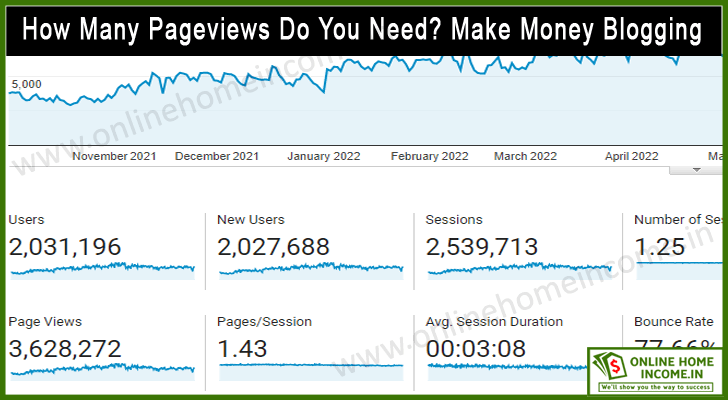Information in many forms has a better reach. Here, we will learn how to repurpose blog content to improve our blog SEO and rank better.
Blogs rich in information with first-hand experiences always find a top spot on search results. It is no wonder that blogs are the go-to spaces for any user searching for something online.
Consequently, blogging became a part-time and full-time profession for many. Blogging’s popularity increased because of its exponential money-making potential.
However, reaching the top spots on search engine result pages (SERPs) and subsequent traffic attraction, monetization, etc., does not happen quickly.
Getting a top organic position for your blog in search results involves adopting many SEO metrics.
One such important strategy is to make sure you repurpose your blog content for SEO.

⇒ Does $10 a day in your bank will make you happy? If so, here is an exciting opportunity for you to start free.
⇒ All you need is a Smartphone with an Internet connection. | Join today!
It means you make your blog content available in various forms online. YouTube videos, infographics, podcasts, newsletters, etc., are some ways to update and explain lengthy blog posts in short.
The more ways you repurpose your blog content, the higher visibility for your blog.
This visibility leads to an overall boost in your image as a blogger. Subsequently, Google improves your authority score and increases your SEO and page ranks.
Let us learn how to repurpose long-form blog content and improve its reach in all online media.
Understanding Content Repurposing
You have a rich blog filled with informative blog posts. By repurposing blog content, you recycle or give a new form to your existing ideas.
Or you can update whatever you have missed earlier in your new content forms.
Repurposing old content is the best way to show the search engines and your followers that you are still in the game.
Furthermore, a crucial advantage of repurposed content is the many forms or channels to publish your blog content.
Brands must leverage all possible channels and make themselves visible in the digital marketing era. This scenario is no different for bloggers.
— For instance, you can have a YouTube video or an Instagram reel featuring you talking about your blog post.
— Or your video can have a presentation with a voiceover explaining your blog post highlights.
If someone happens to watch your YouTube video or reel before they find your blog, they can eventually come to your blog for more insights.
Repurposed content will stay live for a long time on most online channels. Your blog and the repurposed content will never go invisible for relevant search queries.
Scroll further to learn how to repurpose blog content and improve your SEO.
Repurpose Blog Content for SEO
The main aim behind content repurposing is to ensure that your long-form blog content gets different forms to cater to a large audience.
Some may prefer to read lengthy and detailed posts, while others may want to scroll through infographics, hear podcasts, etc.
Did you know that the more repurposed content from your blog improves your SEO?
User experience is an important SEO metric. It is a practice to repurpose blog content to satisfy large users.
Also, leveraging all possible keyword combinations for a single idea is best achieved by splitting them across various repurposed content.
Let us see the impact of repurposing blog content for our blog SEO.
i. Improved SEO Ranking
We all know that the best way to target the top spots for a search query is to include relevant keywords and expected solutions in our content.
There can be more than one traffic-attracting keyword for a particular topic.
Also, many bloggers and content creators will compete for high-traffic keywords. Forcefully stuffing many target keywords in your blogs can make search engine crawlers skip your posts.
In such scenarios, keep each repurposed blog content to one focus keyword.
Ultimately, your blog and repurposed content will cover most of the high-traffic keywords, leading you to the top spots of search queries.
Let us take the example of the popular blog Hebbar’s Kitchen of Archana Hebbar.
This blog is the top cookery blog in Indian vegetarian cuisine worldwide today. If you observe, she keeps updating and repurposing most of her blog content.
Her blog posts have multi-channel content like YouTube videos, short reels on Instagram, Facebook videos, pictorial stepwise representations, and so on.
Sometimes, she reposts the same recipes, altering them to suit the trends.
For instance, her blog has recipes for the traditional chutneys.
— She has posted recipes of chutney premixes where one just needs to add water and prepare instant chutney.
— She also posts videos of recipes like baking with and without an oven.
As a result, her blog posts always find the top spot for relevant recipe queries. Such is the power of SEO when you repurpose blog content.
ii. Increased Audience Engagement
Repurpose blog content in many forms to improve your overall SEO as a blogger.
We have already seen how adding multimedia content like infographics, images, slideshows, etc., finds a way into the Google Images tab. In one way or the other, users will reach your blog post.
Similarly, finding a YouTube video, Instagram reel, or guest post fetches a powerful backlink to your blog.
All such channels where you repurpose your blog content encourage high audience engagement. Organic traffic from any of these channels makes a difference to the traffic coming to your blog.
As we know, SEO prioritizes content that satisfies all kinds of user expectations.
The more forms of related content you publish by repurposing old content, the higher your SEO score.
This metric improves your overall blogging authority.
A long-form blog post deserves organic traffic sources. Repurposed content helps to quickly attract and convert passersby and scrollers to organic traffic.
So, never skip ways to repurpose blog content and increase your SEO chances.

Ways to Repurpose Blog Content in 2024
Content repurposing is no doubt the best way to make sure your old or updated blog ideas reach a wide range of audience.
The key to repurposing old content is to cater the new content to all possible audience groups.
For instance, some visit blogs just to look at their infographics. Others look for pictorial steps.
Some may look for the blog’s name and a supporting YouTube Video alone. Avid readers and search engine crawlers will look for in-depth text descriptions in your blog and repurposed content descriptions.
Also, a multi-channel content presence makes your blog more authentic and authoritative. Let us learn a few ways to repurpose blog content and attract high-quality traffic.
1. Create Infographics from How-To Blog Posts
Infographics are a hybrid combination of images, charts, graphs, and supporting textual information.
Every blogger will have How-To style blog posts, giving various solutions to problem statements in their blogging niche.
The long-form content can be quickly conveyed within 1 – 2 infographics supporting the post.
There are many types of infographics and templates. Depending on your blog topic and the idea conveyed, you may choose what suits you best to design your infographic.
For instance, you may use graphs and supporting text if your blog discusses statistics and facts to establish and prove a theory.
Or, if your blog post involves decision-making, you can add a flowchart infographic to show the decision flow pictorially. Event timelines are also best viewed as infographics.
So let us see the steps to create infographics for your blog post;
- Decide the content from your blog to be highlighted in the infographic.
- Choose a template – flowchart, graph, images, timelines, etc.
- Understand the literacy levels of your audience.
- List the keywords and related data you will add to the infographic.
- Organize the image and data aligned with the template.
- Provide your blog logo or link for reference.
Many image editing and AI tools are available to create infographics for your blog posts. You may add the infographic to your blog post as an update.
Also, you may share them as a promotional post across your social media accounts, blogging peer groups, etc.
2. Make Videos for YouTube (Explanatory or Knowledge)
Today, it is an SEO trend to have a supporting YouTube video for every blog post. All new bloggers today start a YouTube channel along with their blogging domain, attracting traffic for either channel.
If you have not joined the YouTube bandwagon, do not fear. It is never too late to start something new.
If you have already published blog posts, you can repurpose the blog content by creating YouTube videos.
Explain your blog post in detail and keep your explanations short and crisp within a few minutes. You may use tools to explain and illustrate concepts.
However, the latest trend is to purely demonstrate the problem solution without showing the face of the blogger.
Cookery, arts and crafts, and many more videos have a camera focusing on the demonstration alone.
The shorter and crisp the videos, the higher the viewership.
Such videos that focus purely on the solutions can have a voiceover. Or you may provide text or subtitles at various parts of the video and give a different background music.
Numerous video editing tools and templates are available to aid bloggers in creating YouTube videos.
- You want a good-quality camera (DSLR or mobile), a video editing tool, and a high-speed internet connection to upload videos.
Visit my previous post on how to create a YouTube channel to help you get started.
3. Create Shorts for YouTube and Instagram Reels
While long-form blog posts and in-depth video analyses help viewers, most do not have time to complete them fully.
When viewers do not get what they are searching for within a few seconds, there are chances they may skip your content. They may scroll down or simply swipe past your content.
When we discussed about YouTube videos earlier, I mentioned keeping your videos short.
However, it is always not possible to make videos within a few minutes. The main aim of YouTube videos is to provide an in-depth explanation like blog posts but with multimedia.
Like blogs, users may not be patient to view an entire video. If they scroll fast, they may miss important information in your video.
You can create YouTube Shorts or Instagram Reels to ease repurposing blog content as videos. These are short videos spanning a few seconds to a minute.
Is it possible to repurpose blog content to last less than a minute? Yes!
You can create a short video highlighting the solution topics that you give in your blog.
You may also make a reel to generate hype about your new blog post.
— Today, many innovative ways are there to create Instagram reels and Shorts videos.
If you know the latest trends and reel templates, you can merge your content to create innovative short videos that quickly grab attention.
As a result, you will have organic traffic flocking to your blog.
4. Repurpose the Blog Content for Medium
When you publish a blog post, you would have a particular focus keyword and a set of related keywords.
You can repurpose blog content by rewriting the posts for popular blogging platforms like Medium, Hubspot, etc.
Such blog platforms encourage bloggers from different domains to publish blog posts.
However, these platforms have their own set of rules for bloggers before giving them a writing opportunity. You need to have an account and create a profile in Medium.
Then, you need to understand the target audience and their expected vocabulary.
As I mentioned earlier, the same blog can come under different focus keywords.
You can research the trending keywords that bloggers use in that domain.
You can check where your followers belong and frame the content curated to suit Medium, Hubspot, etc.
You won’t need to change your blog skeleton too much, but it must meet the standards specified by the blogging platform.
Some prefer lengthy discussions, some look for more infographics, etc.
The idea is not just about changing focus keywords in your text.
Repurposing blog content in different blogging platforms aims to cater to several audiences.
5. Share Similar Knowledge on Quora
Quora is the most popular Q&A platform for users to share answers to countless questions posted on every domain under the sky.
This place is like a Q&A-based social media where people from similar domains interact in answer threads.
For bloggers, answering questions on Quora provides high-quality backlinks to their blogs. People reading your answers wish to know your domain authority and vice versa.
But how do you know where to share your blog content?
Can you answer any questions?
Quora has this feature where you can search for questions.
This search feature is where your blog post’s focus keywords can help.
Typing them on the search bar shows several user questions involving the topic or the focus keyword.
Then, find questions posted most recently and write answers to them.
You can repurpose old blog content from relevant posts when you provide answers. Summarize your blog post and highlight the core solutions that users want to know.
You may highlight examples from your blog or add infographics or images related to your blog posts.
However, understand that people reading answers on Quora want direct and crisp answers.
They do not wish to be redirected to lengthy blog posts or YouTube videos.
Adding blog links spoils their purpose of asking questions on Quora, which they could have searched themselves.
But remember that if users find your answers convincing for questions from your domain, they will visit your blog. This process is slow but rewarding.
6. Make Podcasts on Key Takeaways of the Blog Post
Like videos, you can repurpose blog content in audio form. Just as you upload videos on your YouTube channel, you can create a Podcast with a series of audio uploads relating to your blog.
Google, Spotify, Apple, Amazon, etc., are some of the top podcasts preferred by artists worldwide.
So, who wants podcasts?
— When we have already provided text, infographics, and video formats for our blog – will anyone want another form?
A large audience loves listening to audio while simultaneously performing other works. YouTube videos, shorts, and reels would not suit this group.
Podcasts are for organic followers who love to plug in their headphones and hear what your blog post discusses.
A lot of story reading and storytelling has been happening through podcasts.
Blogging as an art is like telling a story to solve simple to complex problems. The friendly tone that bloggers use sets it apart from other technical articles.
Publishing podcasts with topics relevant to your blog post is a unique content repurposing strategy.
Again, the key is to keep them short and crisp without boring your listeners.
Just like how your blog text tone is lively and friendly, the person hearing your podcast must get the same feel.
7. Conduct Webinars on the Topic
Webinars or online seminars are live sessions that one can use to educate and share knowledge.
They can be free or paid sessions, with audiences joining from anywhere worldwide.
Furthermore, webinars can be great tools to have detailed discussions of your blog posts with a highly interested group of followers.
This way, you repurpose your blog content and share it with those who wish to benefit from it.
Conducting a webinar is not very hard. You will need a tool like Google Meeting, Skype, Microsoft Teams, etc., to facilitate your webinar.
Promote it in your blog and social media pages, encouraging your followers to participate in the webinar.
Based on the response, understand the knowledge levels of your audience. Are they new followers? Or are they domain experts?
Conduct the webinar based on their activity in your blog and your pages. For example, identify the less known content in your blog and try to focus more on explaining it.
Or share more explanations of the prerequisite concepts that may be hard for new followers to read in your blog posts.
Finally, share the invitation link with your participants and give a clear idea about the takeaways from the session.
8. Create Email Newsletters on the Content
When viewers land on your blog post, you must prompt them to subscribe to your newsletter.
This newsletter is an email publication from your blog that periodically reaches your follower’s mailboxes.
Newsletters are like e-newspapers. But they will contain news about your blog posts.
They can contain 1 – 2 articles featuring your top blog posts for that week or month.
You may have supporting images, infographics, memes, etc., to lure readers to visit our blog.
The newsletter is the best promotional tool to create a buzz about your new and forthcoming blog posts.
You can provide a short gist of the topics discussed and the key points to look out for. Moreover, you can have a section to highlight the top followers of your blog.
You may also announce contests, a quiz based on your latest blog posts, polls, etc.
Like a newspaper, you need to create a professional template for your newsletter.
You may choose any existing templates or create your own with your blog logo.
Then, write a clear and catchy headline with relevant keywords for your blog post. Prepare your content and draft a pitch email to send to your subscribers.
Repurposing blog content in newsletters is the best way to promote your blogs.
You get to keep a tab on your followers. Analytics tools help track how many users check your blog through your newsletter.
9. Go Live on LinkedIn or other SM Platforms
Almost every social media platform provides the option of going live. Facebook, Instagram, LinkedIn, etc., help bloggers interact with followers on each platform.
Live interactions are the best way to promote new blog posts and familiarize followers with your previous posts.
Moreover, going live periodically on your social media handles helps you understand your audience’s pulse.
So, what does going live have to do with repurposing blog content?
Speaking about your previous blog posts helps revive interest and curiosity among your followers.
This strategy is helpful to get your new followers in trend in your blogging domain.
Like how we have discussed for other repurposed content, the key is to keep interactions to the point about the main topic focused in your blog post.
Be ready to face a lot of questions commented on by your followers.
However, do not make your live session meant to repurpose blog content into a Q&A session.
Avoid this by answering only limited and sensible questions and smartly avoiding distractions.
Use your live sessions to highlight the core solutions discussed. If you refer to an old post, mention the updates you have provided.
10. Create Better Versions of the Old Blog Posts
When you publish and promote a blog post – things do not end there. You may continue publishing new posts. But it is crucial to get back and update your old blog posts.
If you want your new followers to become regular readers, you must ensure that content aligns with the latest trends.
For instance, we saw the example of Hebbar’s kitchen updating its recipes frequently.
The key driving factor for a blog post traffic is its focus keyword. However, the focus keyword may change with time.
Another semantically relevant keyword can become trending. So, analyze and incorporate relevant keywords periodically in your blog post.
Internal linking content in your blog posts is another essential parameter that boosts your SEO score.
Your content has sufficient contextual internal links to help users learn prerequisite topics and references in your blog.
Update any irrelevant content and run an audit to delete obsolete internal and external links. Such activities prevent you from getting a negative SEO score.
Finally, update your blog post date to the latest date of update. Search engines prefer recently updated/created blog posts over old posts when ranking on SERPs.
Step-by-Step Guide: How to Repurpose Blog Content?
Now, we know the various ways to repurpose blog content.
Every repurposing content strategy has a unique set of audiences, who turn out to be organic traffic for your blog.
That is why I recommend to keep yourself updated with popular content forms.
Also, learn the latest trends in reels, shorts, memes, etc. See how you can capitalize on the popularity of a trend by innovating it with your blog content.
Let us learn the steps involved in repurposing blog content for SEO.
i. Identify Evergreen and High-Performing Content
There are some content forms that online viewers always prefer. Blogs are one among them, right?
But here, we are looking for alternatives to repurpose blog content.
Some evergreen content forms include YouTube videos and infographics.
When someone searches for your blog with the right keywords, your supporting YouTube videos appear in the top search results. Related images come under a separate tab.
YouTube thumbnails and images also make it to social media like Pinterest, where users can save. So do not skip to repurpose blog content in such evergreen content forms.
Recently, high-performing content come from YouTube shorts, Instagram reels, and podcast episodes.
These are not just promotional tools but provide a short list of helpful information.
Similarly, many more content forms will come in the next few years, and every blogger must target trending content.
Being in trend is not just for promoting your blog posts. It makes sure that your ideas get conveyed in every possible content form.
ii. Choose the Right Format for Repurposing
Your blog has lengthy content targeting various areas. It would be best to have several content forms discussing several aspects of your blog.
This way, you can repurpose your blog content in different formats.
For instance, if you have a blog discussing how to do a volcano at home, your blog will have various sections like;
- What is a volcano? What are its contents?
- What is the science behind volcano eruptions?
- How do you simulate the same at home?
- Steps or ingredients required to prepare a volcano project.
- Safety regulations to follow and parental guidance for children.
Every point above can be repurposed as a new content form, giving insights about the blog post.
The reason for sectioning your blog content for repurposing is to ensure it reaches those interested.
Some may already know about a volcano and its functioning. Those people only want to learn the steps. However, there can be novices who are unaware of a volcano and its science.
So, make sure that your repurposed content forms are updated. They must provide all that users need to know, irrespective of whether they come to your blog post or skip it.
iii. Match the Content with Appropriate Formats
Let us continue the above example we considered. How can we repurpose each of those blog post topics?
- You may create an infographic describing a volcano and its constituents.
- A flowchart to show the conditions leading to a volcano eruption.
- A YouTube video demonstrating the steps to simulate a volcano.
- An Instagram reel or shorts describing the ingredients to make a volcano.
- A podcast or Instagram reel pointing to safety precautions in the project.
- A live session on social media where you demonstrate the volcano.
- A webinar to let audiences show their demos and conduct similar science experiments
Have you come across similar content forms online? Yes, you would have!
If you observe, there are some best forms for certain kinds of content. While no strict rules exist for content forms, trends show that people prefer certain content in their most appropriate formats.
In the above case, even if you have a YouTube video to show the conditions leading to a volcano eruption, adding the same as a flowchart is the best.
The same flowchart can be used as your video thumbnail icon or shown in the video.
So, keep yourself updated about the best formats to repurpose different kinds of content from your blog posts.
Conclusion
Now we know about the importance of content repurposing and how to repurpose blog content.
Giving new forms to your blog posts is always a wise decision.
Providing alternate forms of your old blog posts or updated posts helps give your blogs a wider reach.
— More specifically, they boost your blog SEO.
When you repurpose blog content into YouTube videos, Shorts, Instagram reels, Podcasts, etc., you cater to different sections of organic audience.
All of these channels provide backlinks to your original blog post and your blog website as a whole.
The key is understanding what content suits different topics in your blog posts. So, you must learn about evergreen and current trending content forms and how to create them.
Many tools are available to aid bloggers in creating and editing videos, infographics, audio podcasts, etc.
For instance, one can access filters and reel features on platforms like Instagram.
AI tools make this job easier by generating images, memes, infographics, etc., for just text-based input.
You can see the list of tools I use for blogging and content creation on this page (View my list of Blogging Tools).
So, repurpose blog content in as many forms as possible and boost your blog SEO.







